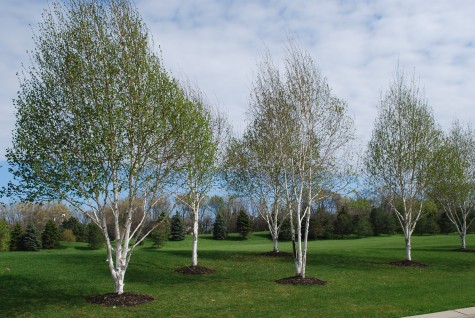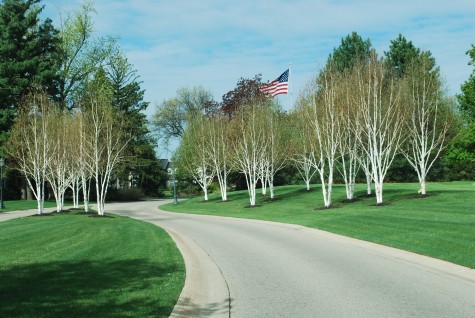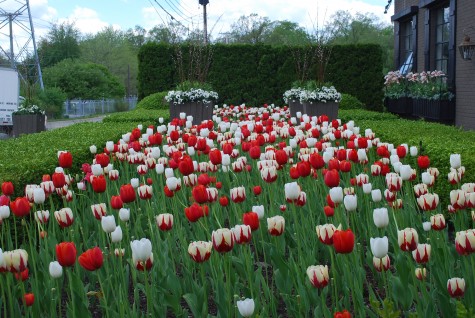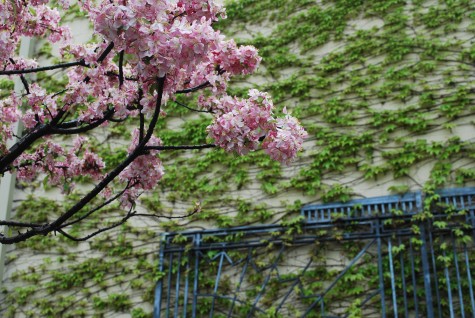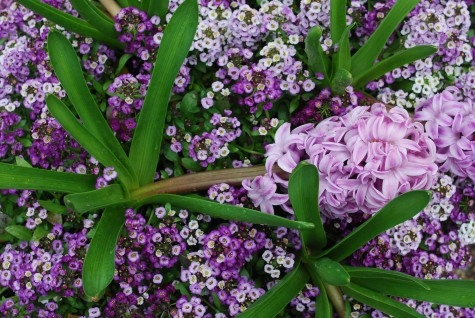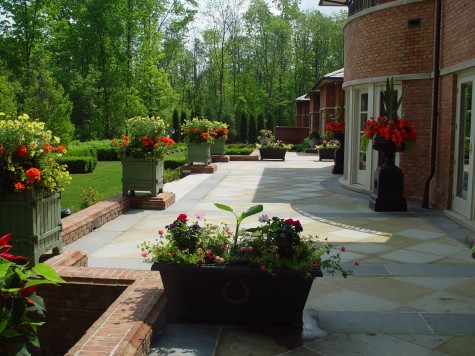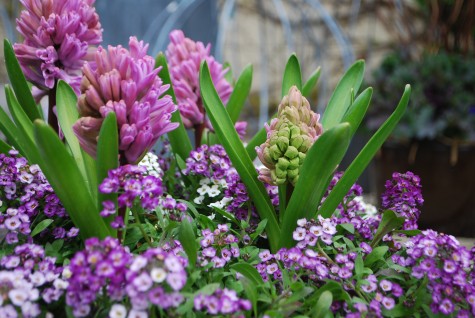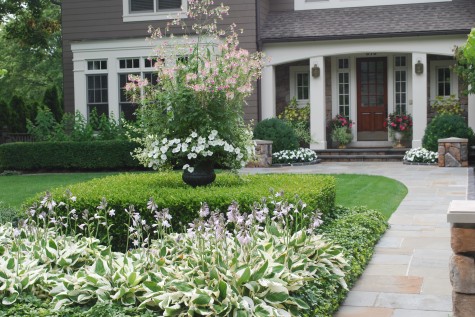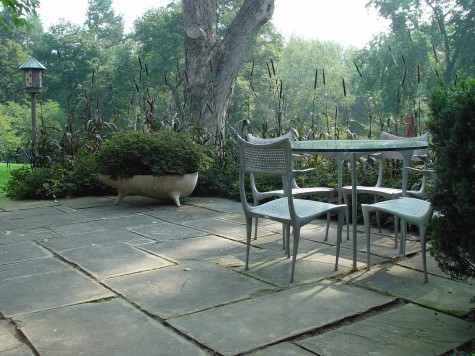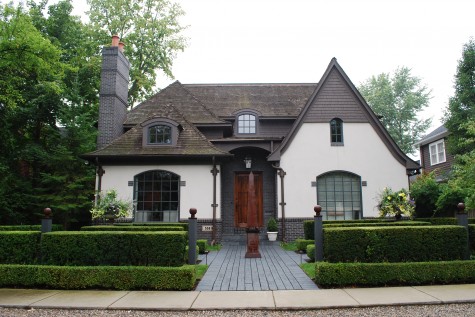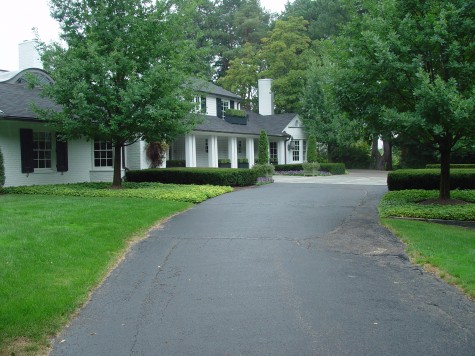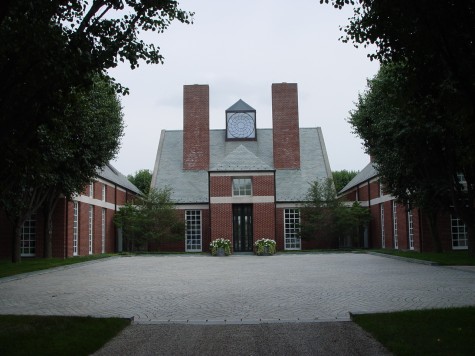Some years ago I landscaped a gated community in our area. I put all my visual bets on groves of scotch pine, and Himalayan white-barked birch. Pinus Sylvestris and Betula Jacquemontii-sounds like an engagement announcement to me. Both trees like sun, and perfectly drained soil. The birch likes cool moist soil; a placement in a lawn panel that gets regular water. The Scotch pine-placed ever so slightly out of range of the overhead irrigation-in drier locations.
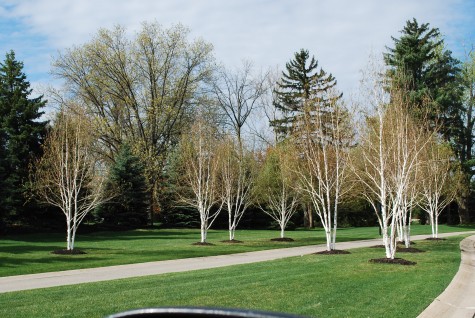 Both species are doing just fine, but no doubt the Himalayan is the looker of the pair. The whitest barked of all the birch, that white bark is evident at a very early age-unlike other species that have to grow up into the white. The striking color of this bark puts it on my dance card of white trees I like to waltz around with. Very susceptible to the bronze birch borer, they need care-just like everything else that is so worth the trouble.
Both species are doing just fine, but no doubt the Himalayan is the looker of the pair. The whitest barked of all the birch, that white bark is evident at a very early age-unlike other species that have to grow up into the white. The striking color of this bark puts it on my dance card of white trees I like to waltz around with. Very susceptible to the bronze birch borer, they need care-just like everything else that is so worth the trouble.
 White flowering trees make the spring landscape spectacular. The magnolias first up, the apples, the Bradford pears, the crabapples-the list of white spring flowering trees is considerable. They bloom before they have foliage. Take a minute to think about that phenomena. Asleep all winter, they burst forth with their show like they have 10 minutes to live. This year the blooming was especially heavy. I am not a big fan of Bradford pears, but my favorite thing about them is when their topmost branches start to green up, while the rest of the tree is still in bloom. A gorgeous spring phase.
White flowering trees make the spring landscape spectacular. The magnolias first up, the apples, the Bradford pears, the crabapples-the list of white spring flowering trees is considerable. They bloom before they have foliage. Take a minute to think about that phenomena. Asleep all winter, they burst forth with their show like they have 10 minutes to live. This year the blooming was especially heavy. I am not a big fan of Bradford pears, but my favorite thing about them is when their topmost branches start to green up, while the rest of the tree is still in bloom. A gorgeous spring phase.
 My dogwoods are coming on strong now. Cornus Florida-when they are good, they are excellent, and when they are bad, they are horrid. I have one tree in the grove with 2 flowers-go figure. They fade from fungus over the summer. They perpetually look wilted, and unhappy. But today, I have no complaints. The flowers keep me coming back for more.
My dogwoods are coming on strong now. Cornus Florida-when they are good, they are excellent, and when they are bad, they are horrid. I have one tree in the grove with 2 flowers-go figure. They fade from fungus over the summer. They perpetually look wilted, and unhappy. But today, I have no complaints. The flowers keep me coming back for more.
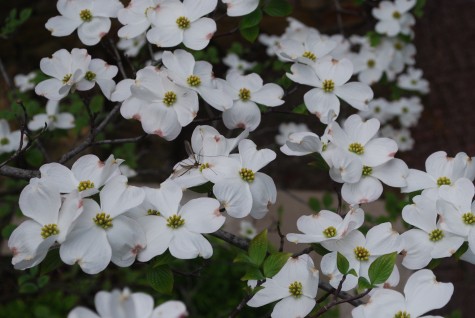 I have a particular interest in single flowers, for whatever reason. Bloodroot, white hellebores, dogwood, white annual phlox, white pansies, daisies, Peony Krinkled White, white poppies, Nicotiana alata, Japanese anemones-you get the idea. White single flowers are especially beautiful. So simple, elegant, and satisfying to the eye.
I have a particular interest in single flowers, for whatever reason. Bloodroot, white hellebores, dogwood, white annual phlox, white pansies, daisies, Peony Krinkled White, white poppies, Nicotiana alata, Japanese anemones-you get the idea. White single flowers are especially beautiful. So simple, elegant, and satisfying to the eye.

The Venus dogwood is no doubt the most spectacular white flowering tree on the planet. A cross between the Pacific dogwood, Cornus Nuttalli, and Cornus Kousa, it has the great characteristics of each, in addition to great hardiness, a fast growth rate, and the most spectacular white flowers I have ever seen. The trees at the shop were in bloom a full month last year, start to finish.
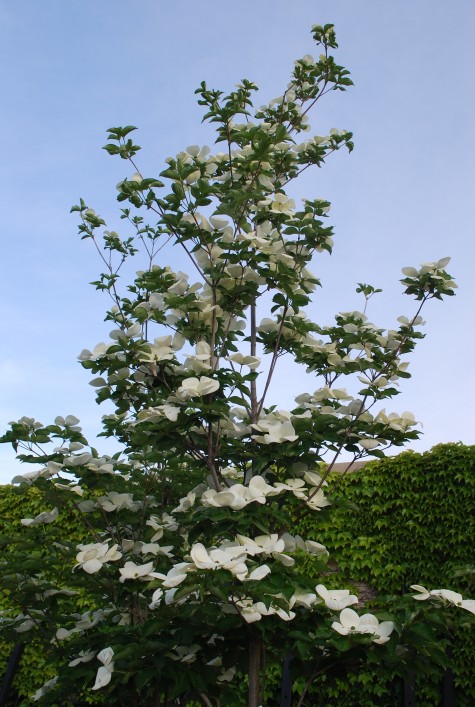
The foliage is large and lush. They do not fruit to speak of, which doesn’t turn me away from them much. I like that I can place them in full sun in my zone, and see them thrive. You can see the size of the trunk in this picture; even an immature tree puts on quite a show.
 I typically buy them as 1″ or 1.5″ caliper trees in 25 gallon pots. This makes it easier for a home gardener to plant them-although those pots are terrifically heavy. Even at this early age, each tree will sport upwards of 300 flowers. Though magnolias can be every bit as willing to bloom, they are fussy about weather conditions. In a warm year, they may drop their flowers in an instant.
I typically buy them as 1″ or 1.5″ caliper trees in 25 gallon pots. This makes it easier for a home gardener to plant them-although those pots are terrifically heavy. Even at this early age, each tree will sport upwards of 300 flowers. Though magnolias can be every bit as willing to bloom, they are fussy about weather conditions. In a warm year, they may drop their flowers in an instant.
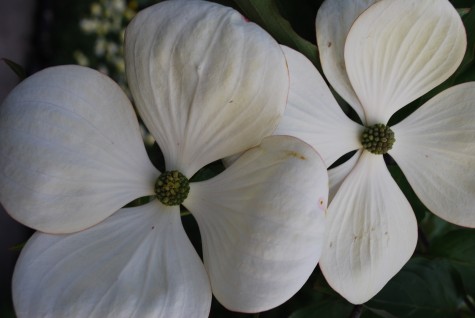 The willingness to grow vigorously and bloom heavily for a long time makes “Venus” my favorite white tree. The trees at the shop are small, and quite green right now; they have inherited that later bloom characteristic from the Kousa parentage. If you like dogwoods, a Venus will greatly extend the spring bloom season beyond Cornus Florida time. The Venus season is just about to begin.
The willingness to grow vigorously and bloom heavily for a long time makes “Venus” my favorite white tree. The trees at the shop are small, and quite green right now; they have inherited that later bloom characteristic from the Kousa parentage. If you like dogwoods, a Venus will greatly extend the spring bloom season beyond Cornus Florida time. The Venus season is just about to begin.
